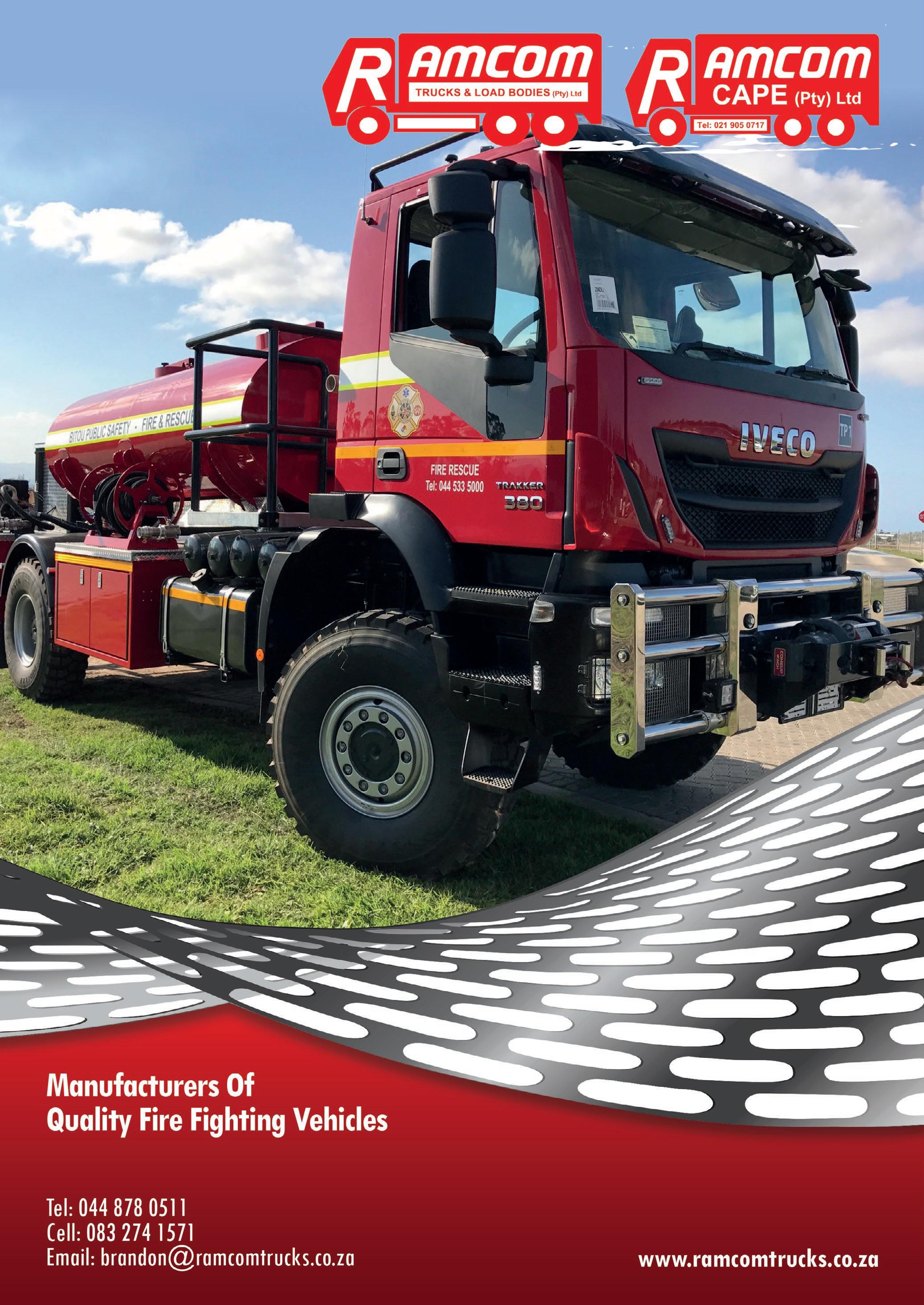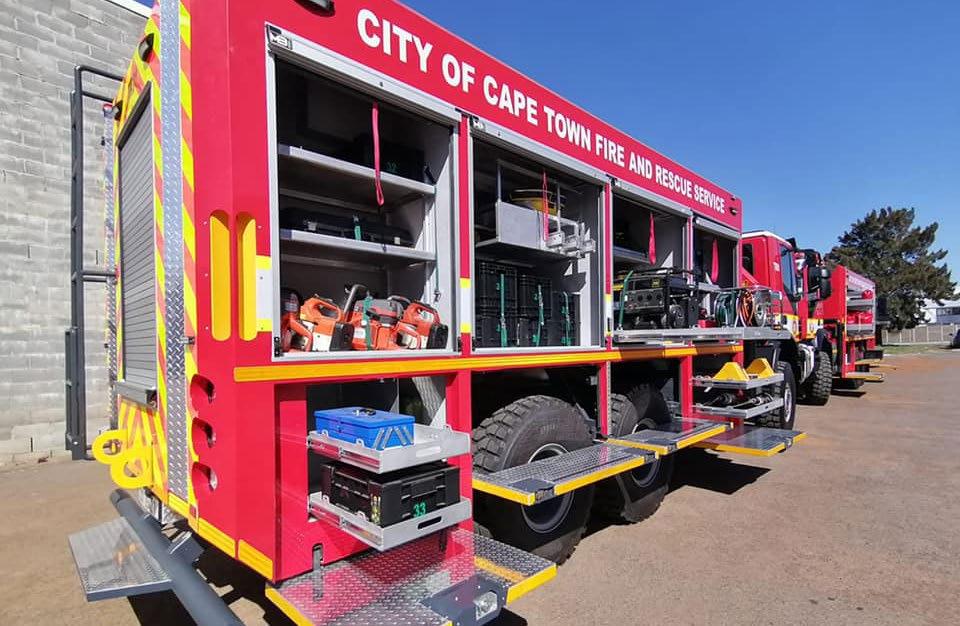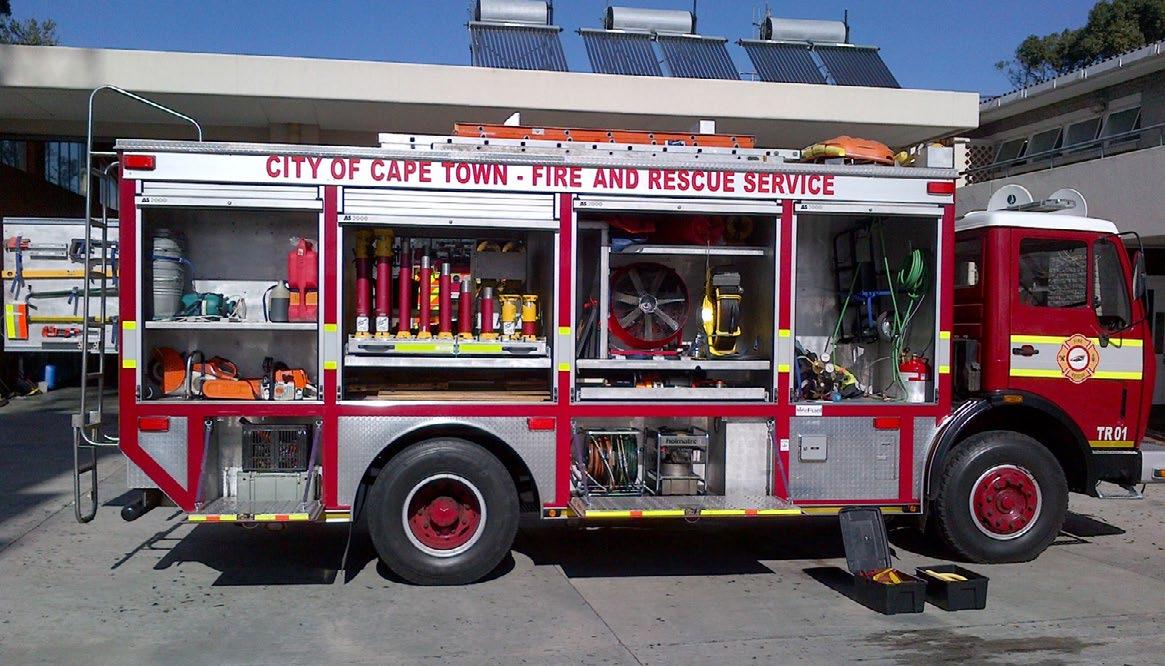
9 minute read
Second generation heavy technical rescue vehicles for City of Cape Town Fire and Rescue Service - by Fred Munnik
Second generation heavy technical rescue vehicles for City of Cape Town Fire and Rescue Service
By Fred Munnik, station commander, City of Cape Town Fire and Rescue Service Training Academy
Advertisement
City of Cape Town Fire and Rescue Service’s two new technical rescue units
The City of Cape Town Fire and Rescue Service unveiled 19 new vehicles at the Epping Fire Station in September 2021. The new fleet featured two specialised technical rescue vehicles and 17 specialised water tenders, said to have cost the City’s Safety and Security Directorate R81 million to acquire. During 2007, in preparation as a host city to the 2010 FIFA World Cup, the City of Cape Town’s Fire and Rescue Service identified the need to uplift its technical rescue and hazardous materials response abilities. Forming part of this endeavour was the addition of a large technical rescue vehicle to its already diverse fleet of emergency vehicles. At the time, the most viable option to achieve this was through the refurbishment of an obsolete Metz Turn Table Ladder based on a 1981 Mercedes Benz 1419 chassis. The appliance was deconstructed in view of overhauling the chassis along with all mechanical and cab body components, minus the ladder and hydraulic operating system.
Having a keen interest in the development of the City’s hazardous materials and technical rescue service delivery capabilities, Station Commander (SC) Frederik Munnik, station officer at the time, took it upon himself to design and overseeing manufacturing and fitment of a new custom payload body onto the refurbished chassis. This repurposed vehicle was designated the call sign Technical Rescue 1 (TR01) and operationally deployed during September 2008 as the City’s first heavy rescue vehicle.
The principle of spatialisation, which refers to the process of translating development priorities and objectives into spatial locations ie district and metropolitan areas, will enable each district, irrespective of whether it has authority to render fire services or not, to have a district wide perspective of fire risks and capabilities required to manage such risks. This will facilitate district-wide implementation of measures to build required capacities and systems in a manner that will enable prioritisation of areas most at risk. Moreover, the District Development Model will enable and enhance joint planning for the provision of fire services by all municipalities within a particular district in cases where the authority to render the function are at local municipality level.
The establishment of District Development Model structures including at political level, provides an opportunity for all key stakeholders to reflect on the fire risks and required capabilities as part of one plans. The establishment of district/metro hubs as part of the overall institutional arrangements for the implementation of the DDM to provide technical expertise and facilitation provides a platform to effectively coordinate and manage fire services related issues. A District Development Model Hub is defined in relation to this as a central place where the implementation of the DDM in relation to the respective district/metro space is coordinated at a technical and working level.
The District Development Model provides an opportunity to enhance district-wide integrated planning for the provision of Fire Services by all role players within a particular district. It is envisaged that the DDM will resolve ‘silo’ planning, budgeting and implementation of Fire Services in a manner that would ensure cohesive service delivery, maximum developmental impact on people’s lives, and socio-economic and spatial transformation.

The total compartmented equipment storage capacity is 28,719 cubic metres

After some 12 years’ service, having had more than her fair share of emergency responses within this new special operations function, TR01 was eventually decommissioned.
Due to the City of Cape Town being an ever-expanding metropole, the need for rendering a technical rescue service did not only remain but increased exponentially. To this end, SC Fred Munnik was again approached to assist in realising the deployment of two new, substantially larger heavy technical rescue vehicles.
Essentially based on the main features of the original design, he set out to improve on identified shortfalls of TR01. Due to the new vehicles being based on a much larger 6x6 wheel drive chassis and having to accommodate a much larger range of equipment, he incorporated some new features within this second round of custom designs. In addition to improving on some smaller features that, at times, may be overlooked during the design and fitment phases, yet impact greatly in the overall functionality of this class of custom built emergency vehicle.
Through the standard tender application process, Ramcom (Pty) Ltd were appointed as the vendor to supply, manufacture and deliver the two new heavy rescue vehicles, in addition to the supply and fitment of various items of equipment. Munnik was greatly assisted by Bruce Martin of Ramcom, who managed to capture and convert his ideas, descriptions and rough sketches into a workable engineering plan. They spent several weeks deliberating on design features and concepts, measuring and building a database of individual equipment items, drafting and scrutinising an electronic 3D model of the load body and individual components and revisiting initial concepts.
During this time, every millimetre of space available was scrutinised and assigned to the best-suited function, thereby maximising the storage capacity of the load body, improving ergonomic access, removal and restowing of equipment, grouping equipment by not only discipline specific items but also incorporating a clean and dirty locker system to improve on personal safety and equipment care and durability. Currently, there are 857 individual items of equipment stored on each of the vehicles, catering for rescue disciplines such as surface and swift water incidents, vehicle and machinery extrications, rope rescue, confined space, trench and structural collapse emergencies.
Vehicle specifications
The prime mover is an Iveco Trakker rigid 6x6 chassis with front and rear axle differential lock, with all axles having single wheel configuration. Dimensions are: overall vehicle length is 9,2 metres, width is 2,55 metres, its height is 3,3 metres and gross vehicle mass (GVM) of 34 tons. The vehicle has a ground clearance of 380mm with 25 degree approach and 20 degree departure angles.
The engine and transmission drive train is an Iveco Cursor 1- litre turbo charged inline V6 diesel engine delivering 420hp/309kW output with maximum torque of 1900Nm@900rpm and fitted with a rear cab mounted snorkel air intake.
The Eurotronic 16AS2630TO automated 16-speed transmission is fitted with a power take-off (PTO) to drive the vehicle mounted crane. There is a split dual circuit anti-lock braking system (ABS) with electronic brake force limitation (EBL) on the rear wheels and an engine turbo brake. Power assisted steering allows for a turning circle of 19,1 metres wall to wall.
Front and rear eyes/hooks, connected directly onto the chassis, act as secure attachment points. Wrap around style tubular stainless steel bull bar on the front houses a WARN97730 series remote controlled electric winch. Hinged rear under ride protection also acts as
The Palfinger PK18500 Performance has a lifting capacity of 8 185kg at 2,00 metres and 570kg at a maximum reach of 18,65 metres

an access step to rear storage area, without affecting the departure angle.
Cab
The cab is a three seat cab with air-suspended driver seat and has a multi-functional steering wheel with touch button controls for real time digital dash display as well as an integrated auto reverse camera, GPS and radio system.
Vehicle lighting and traffic warning systems
Standard vehicle lighting is enhanced by additional fog and white LED spotlights (gizwag) fitted to the front. The roof mounted 1,6 metre, 22 cluster 200 Watt slimline LED light bar, with 10 additional red flashing LED traffic warning lights placed around the vehicle body, along with the 120dba/200 Watt RMS peak power siren speaker with integrated push-totalk PA system, can be operated from the microphone control module or vehicle hooter on steering wheel.

The payload body’s interior and undercarriage is fitted with LEDs for ground and storage locker illumination.
Two LED work lights fitted above the vehicle mounted crane, along with six LED area lights mounted high onto the vehicle payload body exterior ensure illumination of surroundings work area.
The pneumatically operated Teklite 300E NT telescopic mast light provides additional scene illumination by means of four 32 Watt LED floodlights. The mast light is fitted with a safe stop device, not allowing vehicle movement, forward or reverse, unless properly housed.
Payload body
The payload body is constructed of a steel sub frame with an all-aluminium exterior. It is symmetrically proportioned around vehicle centre line, with due consideration to the weight distribution, size and nature of equipment. Payload body dimensions are: length 5,993 metres, width 2,55 metres and inclusive of below chassis bodywork is 2,852 metres in height. All nine upper locker compartments are fitted with roller-shutter style lockable closures that are dust and weatherproof. One set of lockers has a through-and-through layout whilst the remaining seven above chassis lockers are enclosed compartments. The rear locker allows access to the internal long timber storage area that runs the length of the load body.
The four below chassis locker compartment doors and the four wheel arch closures act as non-slip access platforms/steps when opened, hereby improving ergonomic access to upper lockers.
Storage lockers include two vertical and eight horizontal roller shelves, six adjustable and five fixed shelves, along with two vertical fixed partitions and a two tier suspended platform incorporating fixed storage shelves for long length items. Individual storage sleeves and a custom storage unit, incorporating a dropdown wall, secure the set of pneumatic shoring struts and extensions. A rear mounted scaling ladder give access to roof-mounted equipment and the dedicated sheet timber panels’ storage locker. Shelving is fitted with custom designed and manufactured brackets to accommodate and secure specific equipment items using either rubber securing clamps or 25mm webbing straps fitted with an innovative spring loaded quick release buckle.

The total compartmented equipment storage capacity is 28,719 cubic metres.
The four corners of the superstructure are fitted with flush fitting recessed handles, along with handles fitted to the interior of lockers and onto roller shelving ensures safe access and secure handholds when removing or restowing equipment.
Chequer plate is used for all kick plates provided at all mud guards, step treads, decking and platform areas to provide non-slip secure footing and protect paintwork.
The old Metz Turn Table Ladder based on a 1981 Mercedes Benz 1419 chassis
City of Cape Town’s first heavy rescue vehicle, Technical Rescue 1 (TR01) was deployed during September 2008










